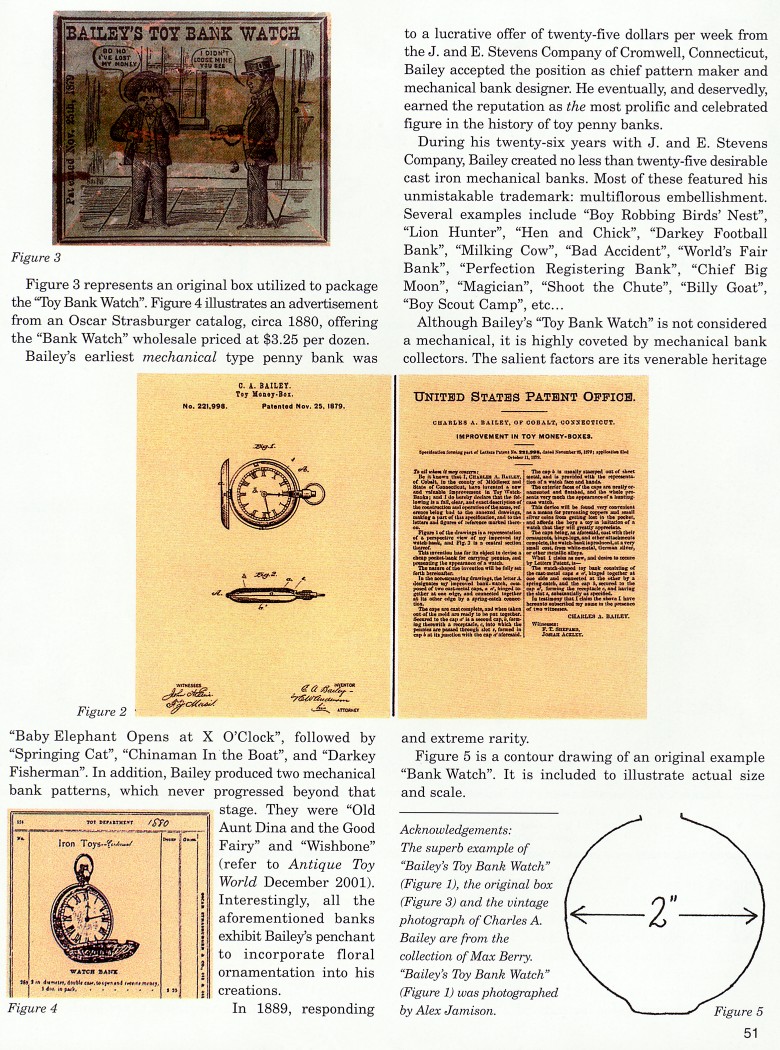|
Charles A. Bailey
and "Bailey's Toy Bank
Watch"
by Sy Schreckinger – ANTIQUE TOY WORLD Magazine – November,
2002
A master in the art of mechanical bank design
was the esteemed Charles A. Bailey. In this month's article he shares the
spotlight with his first creation, a still type penny bank.
Born in Cobalt, Connecticut in 1848, Bailey began his career as a
pattern maker for a local manufacturer of coffin hardware. During this
employ he was introduced to the floral motifs that would dominate nearly
all of his future endeavors. In 1878 Bailey entered into self-employment.
Working from a small shed in the rear of his Cobalt home he produced a
limited number of ingenious pot metal banks composed of lead-zinc alloy.
The first of these was the aforementioned still type penny bank,
which he designated and marketed as "Bailey's Toy Bank Watch" (Figure 1).
Bailey was assigned Patent number
221,998 on November 25, 1879 (Figure 2)
for his invention.
Operation of the "Bank Watch" is quite uncomplicated and efficient.
Initially, the small button inside the brass ring is pressed inward, thus
allowing the top lid of the watch to swing open. This action exposes a
coin slot located along the rim of the watch face between the nine and
twelve o'clock positions. The coin is then inserted into the slot and the
lid cover is closed, manually. Coins are retrieved by reopening the lid
and shaking the deposits out of the slot.
Bailey's intended purpose in creating the "Bank Watch" was expressed
in the patent papers seen in Figure 2: "This devise will be found very
convenient as a means for preventing coppers and small silver coins from
getting lost in the pocket, and affords the boys a toy imitation of a
watch that they will greatly appreciate."
Figure 3 represents an original box utilized to package the "Toy Bank
Watch". Figure 4 illustrates an advertisement from an Oscar Strasburger
catalog, circa 1880, offering the "Bank Watch" wholesale priced at $3.25
per dozen.
Bailey's earliest mechanical type penny bank was "Baby Elephant Opens
at X O'Clock", followed by "Springing Cat", "Chinaman In the Boat", and "Darkey Fisherman". In addition, Bailey produced two
mechanical bank patterns, which never progressed beyond that stage. They
were "Old Aunt Dina and the Good
Fairy" and "Wishbone" (refer to Antique Toy World
December 2001).
Interestingly, all the aforementioned banks exhibit Bailey's penchant to
incorporate floral ornamentation into his creations. In 1889, responding
to a lucrative offer of twenty-five dollars per week from the J. and E.
Stevens Company of Cromwell, Connecticut, Bailey accepted the position as
chief pattern maker and mechanical bank designer. He eventually, and
deservedly, earned the reputation as the most prolific and celebrated
figure in the history of toy penny banks.
During his twenty-six years with J. and E. Stevens Company, Bailey
created no less than twenty-five desirable cast iron mechanical banks.
Most of these featured his unmistakable trademark: multiflorous
embellishment. Several examples include "Boy Robbing Birds' Nest", "Lion
Hunter", "Hen and Chick", "Darkey Football Bank", "Milking Cow", "Bad
Accident", "World's Fair Bank", "Perfection Registering Bank", "Chief Big
Moon", "Magician", "Shoot the Chute", "Billy Goat", "Boy Scout Camp",
etc...
Although Bailey's "Toy Bank Watch" is not considered a mechanical, it
is highly coveted by mechanical bank collectors. The salient factors are
its venerable heritage and extreme rarity.
Figure 5 is a contour drawing of an original example "Bank Watch". It
is included to illustrate actual size and scale.
Acknowledgements: The superb example of "Bailey's Toy Bank Watch"
(Figure 1), the original box (Figure 3) and the vintage photograph of
Charles A. Bailey are from the collection of Max Berry. "Bailey's Toy Bank
Watch" (Figure 1) was photographed by Alex Jamison.
|

